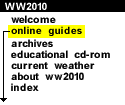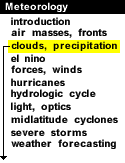
|

Photograph by: Norene McGhiey
When cloud particles become too heavy to remain suspended in the air, they fall to the earth as precipitation. Precipitation occurs in a variety of forms; hail, rain, freezing rain, sleet or snow. This portion of the Clouds and Precipitation module focuses on precipitation and has been organized into the following sections.
|
Sections Latest Update: 07/21/97 |
Rain and Hail
Atmospheric conditions that lead to the development of rain and hail.
Freezing Rain
Sleet
Snow
Acknowledgments
|
The navigation menu (left) for this section is called "Precipitation" and the menu items are arranged in a recommended sequence, beginning with this introduction. In addition, this entire web server is accessible in both "graphics" and "text"-based modes, a feature controlled from the blue "User Interface" menu (located beneath the black navigation menus). More information about the user interface options, the navigation system, or WW2010 in general is accessible from About This Server.

Other Cloud Types |
|

rain and hail |




